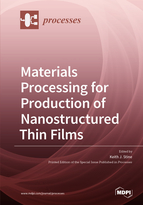Materials Processing for Production of Nanostructured Thin Films
A special issue of Processes (ISSN 2227-9717). This special issue belongs to the section "Materials Processes".
Deadline for manuscript submissions: closed (31 October 2020) | Viewed by 34778
Special Issue Editor
Interests: surface modification; nanomaterials; porous materials; electrochemistry; microscopy; carbohydrates; lipids; biosensors
Special Issues, Collections and Topics in MDPI journals
Special Issue Information
Dear Colleagues,
The production of thin films presenting features on the scale of nanometers is important in different areas of technology, including array technology; displays; surfaces with special optical properties; surfaces with novel wetting or adhesion behavior; as surfaces for cell growth, catalysis, solar energy, chemical or biological sensing; and in medical devices. Such thin films can have unique electronic, optical, magnetic, chemical, biomaterial, or interfacial properties. The processes by which such thin films are produced have expanded to include novel approaches using chemical vapor deposition, physical vapor deposition, atomic layer deposition, patterning using laser or ion beams, self-organized polymerization reactions, controlled corrosion, electrodeposition onto templates, chemical surface modification, electroless deposition, and other specialized material processing methods. This Special Issue is intended to feature methods for producing nanostructured thin films, new developments, detailed characterizations of thin film structure and properties, and examples of their application.
Prof. Dr. Keith J. Stine
Guest Editor
Manuscript Submission Information
Manuscripts should be submitted online at www.mdpi.com by registering and logging in to this website. Once you are registered, click here to go to the submission form. Manuscripts can be submitted until the deadline. All submissions that pass pre-check are peer-reviewed. Accepted papers will be published continuously in the journal (as soon as accepted) and will be listed together on the special issue website. Research articles, review articles as well as short communications are invited. For planned papers, a title and short abstract (about 100 words) can be sent to the Editorial Office for announcement on this website.
Submitted manuscripts should not have been published previously, nor be under consideration for publication elsewhere (except conference proceedings papers). All manuscripts are thoroughly refereed through a single-blind peer-review process. A guide for authors and other relevant information for submission of manuscripts is available on the Instructions for Authors page. Processes is an international peer-reviewed open access monthly journal published by MDPI.
Please visit the Instructions for Authors page before submitting a manuscript. The Article Processing Charge (APC) for publication in this open access journal is 2400 CHF (Swiss Francs). Submitted papers should be well formatted and use good English. Authors may use MDPI's English editing service prior to publication or during author revisions.
Keywords
- Thin film
- Nanostructure
- Physical vapor deposition
- Chemical vapor deposition
- Atomic layer deposition
- Electrodeposition
- Electroless deposition
- Surface polymerization
- Colloidal template






